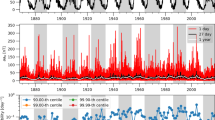Summary
The continuous measurement of the secular variation (SV) of the Earth's magnetic field is a task of highest priority at the Wingst Geomagnetic Observatory of the Deutsches Hydrographisches Institut. As, by nature, SV progresses very slowly, the devices — i. e., the base-line instruments and, logically, those variometers the baselines of which the measurements are reduced accordingly — have to keep their magnetic standards over several decades. Moreover, modern developments in the field of construction of instruments have to be utilized in order to improve and/or ensure the standards.
This paper describes by means of some examples, where priorities have been placed in the last few years. Problems which have arisen in this connection show where the limits of the measurement accuracy are set.
Zusammenfassung
Vorrangige Aufgabe des Erdmagnestischen Observatoriums Wingst des Deutschen Hydrographischen Instituts ist die laufende Messung der Säukularvariation (SV) der erdmagnetischen Feldgrößen. Da die SV naturgemäß sehr langsam fortschreitet, müssen die Geräte — d.h. die Basisinstrumente und konsequenterweise auch die Variometer, auf deren Basen die Messungen reduziert werden — ihren magnetischen Standard über Jahrzehnte halten. Darüberhinaus müssen moderne Entwicklungen im Instrumentenbau genutzt werden, um den Standard zu verbessern und zu sichern.
In dieser Arbeit wird an einigen Beispielen dargestellt, wo in der jüngsten Vergangenheit Schwerpunkte gesetzt wurden. Probleme, die in diesem Zusammenhang auftraten, zeigen, wo die Grenzen der Meßgenauigkeit liegen.
Résumé
La mesure en continu des variations séculaires du champ magnétique terrestre constitue l'une des priorités les plus élevées de l'observatoire de géomagnétisme du Service Hydrographique Allemand à Wingst. Du fait de l'extrême lenteur de la variation séculaire, l'instrumentation — c'est-à-dire les appareils d'observation de la direction de référence et les variomètres dont les directions de référence sont utilisées pour la réduction des mesures — doit conserver ses caractéristiques magnétiques pendant plusieurs décades. De plus, les derniers progrès réalisés dans le domaine de l'instrumentation doivent être exploités pour améliorer et/ou garantir la qualité des références.
En s'appuyant sur quelques exemples, la présente étude décrit l'ordre des priorités adopté ces dernières années. Les difficultés rencontrées à cette occasion montrent où se situent les limites de la précision des mesures.
Similar content being viewed by others
References
Schulz, G. and U. Carstens, 1979: A period measuring proton magnetometer with a direct readout. Dt. hydrogr. Z.32, 119–125.
Schulz, G., 1981: Base-line measurements of the declination, by means of a proton vector magnetometer, at the Wingst Geomagnetic Observatory (Erdmagnetisches Observatorium Wingst). Dt. hydrogr. Z.34, 26–37.
Schulz, G. and D. Voppel, 1981: A comparison of momentary values between 22 European geomagnetic observatories continued over many years. Manuscript presented at the 4th IAGA Scientific Assembly, Edinburgh, Aug. 3–15, 1981.
Schulz, G., 1983: Experience with a digital recording magnetometer system at Wingst Geomagnetic Observatory (Erdmagnetisches Observatorium Wingst). Dt. hydrogr. Z.36, 173–190.
Deutsches Hydrographisches Institut, 1965: Preface in: Ergebnisse der erdmagnetischen Beobachtungen im Observatorium Wingst in den Jahren 1961 und 1962. Deutsches Hydrographisches Institut. Erdmagn. Jahrb.13, Hamburg.
Voppel, D., 1969: Ein Spulentheodolit zur Messung der erdmagnetischen Komponenten mit dem Protonenmagnetometer. Z. Geophys.35, 151–159.
Voppel, D., 1972: The proton vector magnetometer at Wingst Observatory. Deutsches Hydrographsiches Institut. Erdmagn. Jahrb.17, 133–149, Hamburg.
Voppel, D., 1988: Some remarks on the history of Wingst Geomagnetic Observatory during the first 50 years. Dt. hydrogr. Z.41, 109–117.
Author information
Authors and Affiliations
Rights and permissions
About this article
Cite this article
Schulz, G. The standard of Wingst Geomagnetic Observatory (Erdmagnetisches Observatorium Wingst) — its improvement and preservation, demonstrated by some examples. Deutsche Hydrographische Zeitschrift 41, 119–129 (1988). https://doi.org/10.1007/BF02225922
Received:
Accepted:
Published:
Issue Date:
DOI: https://doi.org/10.1007/BF02225922




